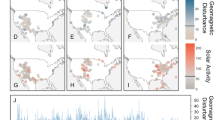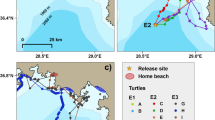These migratory animals have their own equivalent of a global positioning system.
Abstract
Migratory animals capable of navigating to a specific destination, and of compensating for an artificial displacement into unfamiliar territory, are thought to have a compass for maintaining their direction of travel and a map sense that enables them to know their location relative to their destination1. Compasses are based on environmental cues such as the stars, the Sun, skylight polarization and magnetism2, but little is known about the sensory mechanism responsible for the map sense3,4. Here we show that the green sea-turtle (Chelonia mydas) has a map that is at least partly based on geomagnetic cues.
This is a preview of subscription content, access via your institution
Access options
Subscribe to this journal
Receive 51 print issues and online access
$199.00 per year
only $3.90 per issue
Buy this article
- Purchase on Springer Link
- Instant access to full article PDF
Prices may be subject to local taxes which are calculated during checkout

U. KEUPER-BENNETT

Similar content being viewed by others
References
Able, K. P. J. Avian Biol. 32, 174–183 (2000).
Gould, J. L. Curr. Biol. 8, R731–R738 (1998).
Wiltschko, R. & Wiltschko, W. Anim. Behav. 65, 257–272 (2003).
Avens, L. & Lohmann, K. J. J. Exp. Biol. (in the press).
Lohmann, K. J. & Lohmann, C. M. F. in Loggerhead Sea Turtles (eds Bolten, A. B. & Witherington, B. E.) 44–62 (Smithsonian Institution Press, Washington, 2003).
Avens, L., Braun-McNeill, J., Epperly, S. & Lohmann, K. J. Mar. Biol. 143, 211–220 (2003).
Limpus, C. J. et al. Wildl. Res. 19, 347–358 (1992).
Lohmann, K. J., Hester, J. T. & Lohmann, C. M. F. Ethol. Ecol. Evol. 11, 1–23 (1999).
Gould, J. L. Nature 296, 205–211 (1982).
Lohmann, K. J. & Lohmann, C. M. F. J. Exp. Biol. 194, 23–32 (1994).
Author information
Authors and Affiliations
Corresponding author
Ethics declarations
Competing interests
The authors declare no competing financial interests.
Rights and permissions
About this article
Cite this article
Lohmann, K., Lohmann, C., Ehrhart, L. et al. Geomagnetic map used in sea-turtle navigation. Nature 428, 909–910 (2004). https://doi.org/10.1038/428909a
Issue Date:
DOI: https://doi.org/10.1038/428909a
This article is cited by
-
Avian navigation: the geomagnetic field provides compass cues but not a bicoordinate “map” plus a brief discussion of the alternative infrasound direction-finding hypothesis
Journal of Comparative Physiology A (2024)
-
Deformation and Locomotion of Untethered Small-Scale Magnetic Soft Robotic Turtle with Programmable Magnetization
Journal of Bionic Engineering (2024)
-
Sense of doubt: inaccurate and alternate locations of virtual magnetic displacements may give a distorted view of animal magnetoreception ability
Communications Biology (2023)
-
Magnetic Navigation in Animals, Visual Contrast Sensitivity and the Weber–Fechner Law
Neuroscience and Behavioral Physiology (2023)
-
Insect magnetoreception: a Cry for mechanistic insights
Journal of Comparative Physiology A (2023)
Comments
By submitting a comment you agree to abide by our Terms and Community Guidelines. If you find something abusive or that does not comply with our terms or guidelines please flag it as inappropriate.



